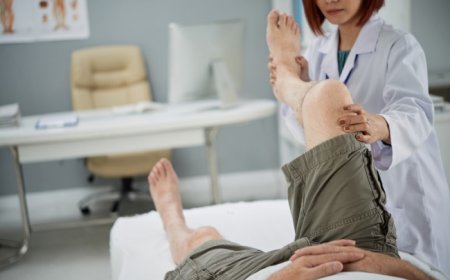From Healing to Harm: Recognizing the Warning Signs of Infected Wounds
Learn how to spot the warning signs of an infected wound. Understand the difference between a healthy vs infected wound and discover expert care tips to prevent complications and support proper healing.

Wounds are an unavoidable part of lifewhether from minor scrapes, surgical procedures, or chronic conditions. While the human body is equipped with powerful self-healing mechanisms, not all wounds follow a smooth recovery path. Some transition from a healthy healing process to a more dangerous state due to infection. Recognizing the early warning signs can help prevent complications and ensure proper care. In this article, we will explore the key differences between ahealthy vs infected wound what causes infections, and how to take action to protect your health.
Understanding the Basics of Wound Healing
A wound occurs when the skin or underlying tissue is damaged by injury, surgery, or disease. The body immediately begins the process of repair through four primary stages:
1. Hemostasis
The blood vessels constrict and form a clot to stop bleeding and create a scab.
2. Inflammation
White blood cells arrive at the site to destroy pathogens and remove damaged tissue. Mild redness, warmth, and swelling are normal during this stage.
3. Proliferation
New tissue begins to form, including collagen and blood vessels. This leads to wound closure and granulation tissue formation.
4. Maturation (Remodeling)
The final stage involves the strengthening of new tissue and the fading of scars over time.
When these stages progress without disruption, the result is a healthy wound. However, infections can interfere with this healing process and lead to serious complications.
Healthy vs Infected Wound: What Are the Differences?
Understanding the distinction between a healthy vs infected wound is essential for proper wound management. Heres a breakdown of what to look for in each case.
Signs of a Healthy Wound
A wound thats healing properly typically exhibits the following features:
-
Redness and swelling: Slight and localized, peaking within the first 13 days.
-
Clear or slightly yellow drainage: Indicates natural cleaning by the body.
-
Granulation tissue: Pink, moist tissue that shows active healing.
-
Scab formation: Protects the wound and allows new skin to grow underneath.
-
Pain reduction: Pain should gradually decrease each day.
-
No foul odor: A clean, healing wound should not produce a strong smell.
Signs of an Infected Wound
In contrast, an infected wound shows signs of worsening rather than improvement:
-
Increased redness: Spreading beyond the wounds edge or developing red streaks.
-
Pus or thick discharge: Green, yellow, or white fluid that may smell foul.
-
Swelling that worsens: Instead of subsiding, swelling becomes more severe.
-
Heat at the wound site: A hot sensation may signal localized infection.
-
Pain that intensifies: Persistent or increasing discomfort is a red flag.
-
Fever and fatigue: Systemic symptoms indicate the body is fighting an infection.
-
Wound darkening or breakdown: Necrotic (dead) tissue may appear if infection spreads.
Common Causes of Wound Infection
Wound infections can be caused by several risk factors. Some of the most common include:
-
Poor hygiene or wound care
-
Dirty or contaminated wounds
-
Underlying health conditions (e.g., diabetes, vascular disease)
-
Immune system suppression
-
Excessive moisture or lack of proper dressing
-
Foreign objects left in the wound
-
Delayed treatment of the wound
Even minor wounds can become infected if not cleaned and monitored properly.
Why Early Detection Matters
Infections can quickly progress from localized irritation to systemic conditions like cellulitis, abscesses, or sepsis. Catching the warning signs early allows for effective treatment and minimizes health risks.
Some infected wounds may require:
-
Oral or topical antibiotics
-
Drainage or debridement (removal of infected tissue)
-
Advanced wound dressings
-
Referral to a wound care specialist
Prompt treatment prevents complications and ensures that the body can return to its normal healing process.
Proper Wound Care Tips
Taking the right steps immediately after sustaining a wound can significantly reduce the risk of infection. Follow these essential care tips:
1. Clean the Wound Gently
Rinse the area with clean water or saline. Avoid using hydrogen peroxide or iodine unless directed by a healthcare provider.
2. Apply a Topical Antibiotic
Use over-the-counter antibiotic ointments to prevent bacterial growth.
3. Cover with a Sterile Dressing
A clean bandage keeps out dirt, bacteria, and other contaminants.
4. Change Dressings Daily
Replace dressings at least once a day or when they become wet or dirty.
5. Keep the Wound Dry and Protected
Avoid submerging the wound in water. Showering is typically fine if the area is covered.
6. Avoid Picking or Scratching
Let scabs form and fall off naturally. Picking can introduce bacteria.
7. Monitor the Wound Daily
Check for signs of infection like redness, swelling, or unusual discharge.
When to Seek Medical Help
While many minor wounds can be managed at home, certain signs require professional attention. Contact a healthcare provider if:
-
Redness or swelling continues to spread
-
Thick or smelly discharge is present
-
Pain increases instead of improving
-
You develop a fever or chills
-
The wound isnt healing after 710 days
-
You have diabetes, poor circulation, or other health issues that impair healing
-
The wound was caused by a bite, rusted object, or dirty environment
Acting early can prevent long-term complications and support proper healing.
Chronic Wounds and Special Care
Some woundsespecially those related to diabetes, pressure ulcers, or venous insufficiencyrequire ongoing care. These wounds are more susceptible to infection and may need specialized treatments like:
-
Negative Pressure Wound Therapy (NPWT)
-
Hydrocolloid or foam dressings
-
Hyperbaric oxygen therapy
-
Customized wound care plans from specialists
If you or a loved one has a wound that won't heal, consult a wound care clinic for expert guidance.
Supporting the Bodys Natural Healing Process
In addition to topical care, your overall health plays a vital role in how quickly and effectively wounds heal. Consider the following tips:
-
Stay hydrated Fluids support cellular repair.
-
Eat a balanced diet Protein, vitamins A and C, and zinc are essential for tissue growth.
-
Avoid smoking Nicotine restricts blood flow and slows healing.
-
Exercise regularly Good circulation supports oxygen delivery to wounds.
-
Manage chronic conditions Keep blood sugar, blood pressure, and cholesterol under control.
Conclusion: Take Action Before Harm Escalates
Knowing how to distinguish a healthy vs infected wound is key to taking timely, informed action. While the body is remarkably capable of healing, infections can derail recovery and put your health at risk. By staying alert to the early signs of infection and practicing proper wound care, you give yourself the best chance of healing without complications.
If you're ever uncertain about a wound's condition, dont hesitate to seek medical advice. Prompt care makes the difference between healing and harm.



























